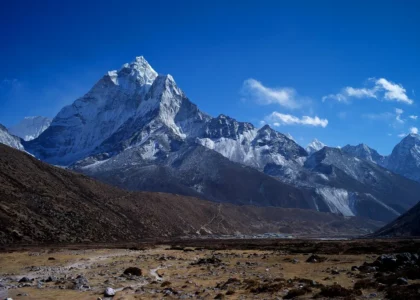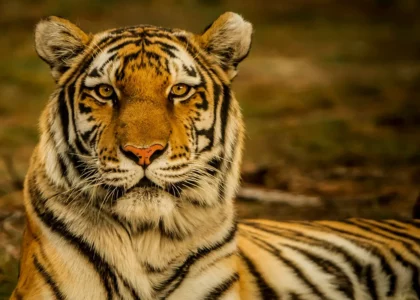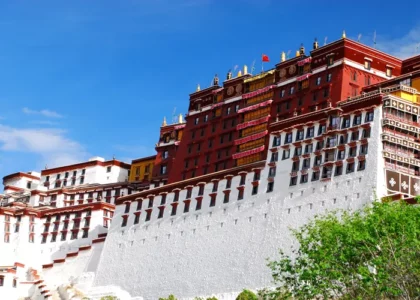Tihar Festival, Nepal Festival of Lights and Flowers
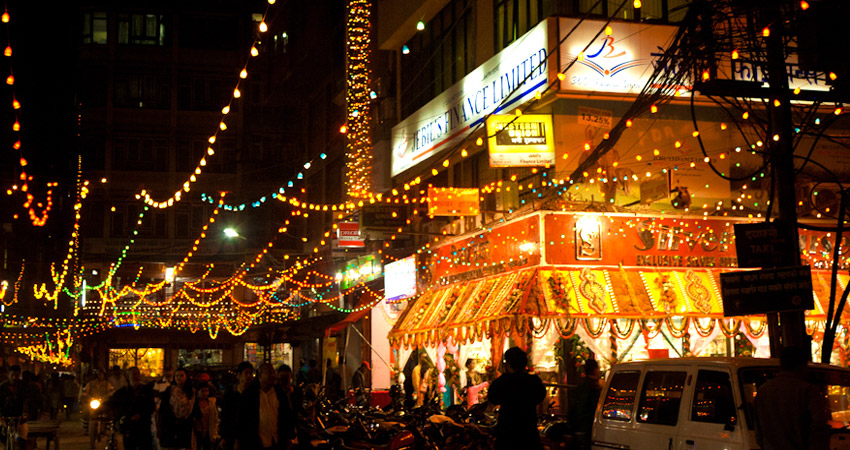
Nepal is a multi-lingual and multi-cultural country. So, people do observe multiple feasts and festivals. All festivals have a particular occasion, sort of an ending of gods over demons, the birth of somebody, and so on. Out of them, Deepawali is the prime national festival. It usually falls at the end of October. Tihar festival is one of the most popular in Nepal.
Nepal is a multi-lingual and multi-cultural country. Each festival depicts peculiar characteristics ranging from Jatra to the most significant festival, Dashain. People celebrate festivals that differ regionally or according to ethnicity, religion, and traditions. Tihar, also called Diwali or Deepawali, ranks second only to Dashain in Nepal, as many candles and festive lanterns will be lit up for the Goddess of Laxmi. Therefore, Tihar is also well-known as the festival of lights.
Tihar comes after the Dashain, and Kathmandu can be seen as the city of lights at night.
Tihar festival often falls between mid-October and mid-November. This festival honors crows, dogs, cows, and Laxmi(the goddess of wealth and luck).
Tihar festival is celebrated after the Dashain festival.
After Dashain, Tihar is the second biggest festival celebrated in Nepal. This festival is mainly dedicated to five days.
The Tihar Festival is Nepal’s second biggest festival, celebrated for five days. Each Tihar holiday has its speech, peculiar functionalities, and importance. On the first day, people worship crows, considered “the messenger of death.”
On the second day of Tihar, dogs are honored and considered “the guardians of the god of death.” The third day welcomes the deity of Laxmi. However, on the fourth day, we worship the cow, Nepal’s National animal.
The final day of the Tihar festival is called Bhaitika or Tihar Tika. It is the day of exchanging happy gifts among brothers and sisters. All family members, away from home, celebrate joyously. They share their joy and eat delicious food.
Tihar Festival 2026 starts on October 30, 2026, and ends on November 03, 2026. Nepali dates start on Kartik 14, 2083, and end on Kartik 18, 2083.
| Date | Day | Activities |
| October 30 2024 | KaagTihar | Worshipping Crows and offering foods |
| October 31 2024 | KukurTihar | Worshipping Dogs and offering meals |
| November 01 2024 | Laxmi Puja | Worshipping Cows and Goddess Laxmi, Playing Bhaile |
| November 02 2024 | Goru Tihar | Honoring for Ox and Gobhardhan puja |
| November 03 2024 | BhaiTika | Worshiping Brothers/sisters, Exchanging gifts |
Here are the first essential things Nepalese people do in Tihar:
- Give Your Home a Makeover with the Best Color
- Make it a Family Affair
- Light Firecrackers
- Send best wishes to all your friends and relatives through messages, media
- Socialize with people
Traditions of the Tihar Festival
After Dashain, the Tihar festival is Nepal’s second biggest festival. This festival is also mainly dedicated to five days. Each Tihar holiday has its speech and portrays peculiar functionalities and importance. The first day of Tihar is to worship crows, considered “the messenger of death.”
The second day of the Tihar festival is to honor dogs considered “the guardian of the god of death.” The third day is the welcoming day of the deity of Laxmi. However, on the fourth day, we worship the cows, a National animal of Nepal. The final day of the Tihar festival is called Bhai Tika or Tihar Tika, the day of exchanging happy gifts among brothers and sisters. All the family members away from home gathered together and celebrated joyously. They celebrate their joy with each other and eat delicious food.
Following is a detailed explanation of each day of the Tihar festival and what importance it depicts:
Nepal Dog Festival 2026/2027
Nepal Dog Festival is an annual Hindu festival held throughout Nepal. It falls on the second day of the celebration of Tihar (around October or November). Today, people worship dogs and give them good food. They put marigold flower bangles on the dogs’ necklaces to please Yama, the god of death, as dogs are his messengers.
Day 1: KaagTihar/Crow Day
Activities: worshiping crows
Date: October 30, Wednesday
Kaag Tihar is marked as the first day of the Tihar. Today, people offer rice to the crows, “the traveler of death.” This day is called the resting day for the crows as they are busy all year spherical. People worship crows to ensure the crow’s area unit is happy. Otherwise, they’ll inform the bad news, and nasty things will happen within the coming year.
People worship crows and ravens and offer them sweets and dishes by placing them on the roofs of houses. In Hinduism, the crawling of ravens and crows symbolizes sadness and grief. Thus, devotees offer sweet food to crows to sort out pain and depression in the coming days. This day also represents divine attachment between humans and other animals.
Day 2: Kukur Tihar/Dog Day
Activities: Thanking dogs
Date: October 31, Thursday
Kukur Tihar is the second day of the Tihar festival, the day of thanking and worshiping gods. Kicha puja is the name given by the Newar community to this day. On these days, Nepalis can honor dogs, for they believe that the dog will guarantee the souls of the dead to induce them to heaven. Individuals offer dogs with Tihar Tika and flower garlands, so treat them with a sweet dinner. Dogs are regarded as “the gatekeeper of death” and seen as the messengers of Lord Yamaraj. This day is also observed as Narka Chaturdashi.
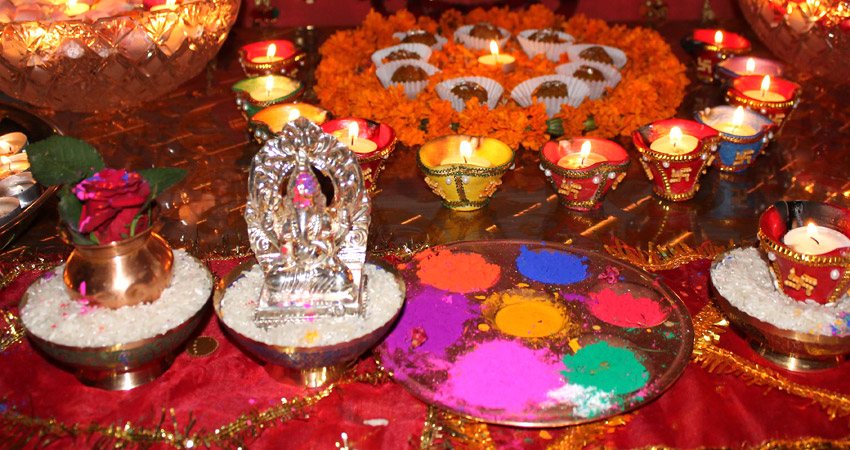
Day 3: Laxmi Puja
Activity: Worshiping Goddess Laxmi
Date: November 01, 2026, Friday.
The third day is of immense significance and is called Laxmi Puja. On this day, people also worship cows. In Hinduism, a cow signifies prosperity and wealth. In ancient times, people benefited greatly from cows.
Thus, on this day of the Tihar festival, people show gratitude to cows by garlanding and feeding them with the best grass. It regards Goddess Laxmi entering the clean house and decorating it with this belief. As a result, People clean their homes, and the doorways and windows are well furnished with garlands made from marigolds (Sayapatri).
Most of the homes are clean and ornately decorated. This can be a gesture to the Hindu Goddess Laxmi to come back down and bless the house with wealth and sensible luck.
In the evening, Every home prays to the Goddess Laxmi, the goddess of wealth. She thanks the families for all the benefits that are bestowed on them. Every house and shop is lit on the gate by oil lamps (Diyo) or candles on doorways and windows to welcome prosperity and well-being.
Besides this, girls play Bhaili by singing folk Bhai songs, dancing, and visiting all the houses in the neighborhood. People will give them money and other sweets as a tip and share them among themselves. Other than that, the night of this day is worth watching, as we can observe the lights all over the country that will give you fascinating views.
Day 4: Govardhan Puja/Guru puja
Activity: worshiping Oxen
Date: November 02, 2026, Saturday
The fourth day of the Tihar festival is called Govardhan puja/Goru puja/Omaha puja and is celebrated according to the people’s specific background. As the ox is an imperative helper for the farmer, individuals can perform Goru Puja for the ox. This day, also called Omaha Puja, celebrates the Newari New Year.
The Newari community celebrates Maha puja/Ma puja(worship of self) gatherings at night. Then all the members can have a special family feast and revel in some lucky food, like poached eggs, deep-fried fish, tasty desserts, etc. People following Vaishnavism perform Govardhan Puja, which is worship towards Goverdhan Mountain.
Cowdung represents the mountain and is worshiped. The nights are decorated with different-colored lights. During the night, the Boys mostly sang Deusi songs and told the story of the festival, with one person in the group narrating and the rest as the chorus. They got some money, fruits, and Selroti from the house owners.
However, nowadays, many social workers, politicians, and young people visit local homes and sing these songs. The funds they receive from playing deuce are collected for welfare and social activities.
Day 5: Bhai Tika
Activities: Worshiping Brothers and Sisters
Date: November 03, 2026, Sunday
The final day of the Tihar festival is called BhaiTika. This is the day of brothers and sisters, who gather after so much time on the auspicious occasion of BhaiTika. “Yampanchak” is another name that is given to Tihar. These days, brothers and sisters can gather and settle for Tihar quotes on their foreheads. Sisters put the multi-colored tika on their brother’s forehead and splendid garlands and supply them with some Shaguns (a quiet candy) as a Tihar gift.
And so, the brothers would follow a constant ritual of placing Tika on their sisters and providing them some cash reciprocally. This festival is celebrated to strengthen the brothers/sisters’ relationship. And among those festivals, Tihar( Deepawali) is one of the celebrations.
The sisters put Saptarangi (7 coloreds) tika or tilaka on the foreheads of their brothers, and the brothers also put the same 7-colored tika on their sister’s forehead. Sisters worship their brothers, wishing for prosperous lives in the future.
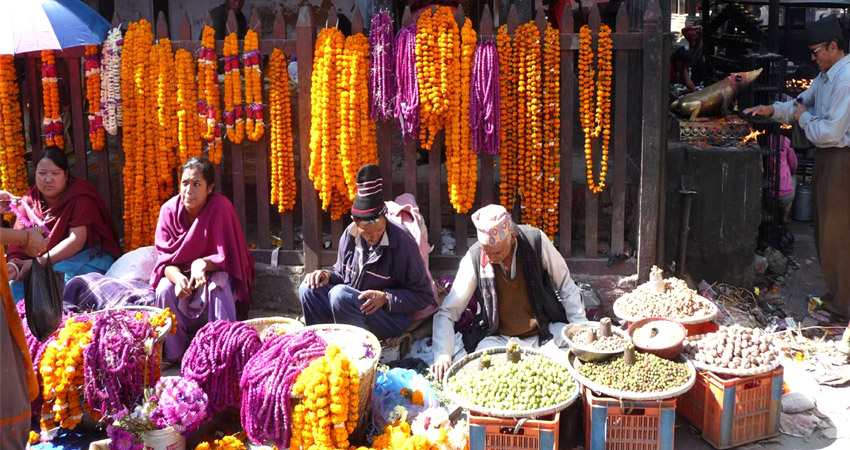
Celebrations of the Tihar Festival
During the Tihar festival, relatives and friends meet each other and exchange Tihar gifts and greetings with each other. Generally speaking, Nepalis will celebrate eleven great festivals from mid-October to mid-November. Each house, store, and shopping complex will light various colorful lights. Tihar festival is also famous as Deepawali and is considered the “festival of lights.” All the city houses.
Importance of the Tihar Festival in Nepal:
The festival of light, the Tiharr festival, is celebrated as it marks the victory of good over evil. However, This festival strengthens the relationship between animals and humans by observing crows: cows, dogs, and ox. People indulge in feasting and also rejoicing. They clean their houses, put on new clothes, and also taste various types of delicious foods. This festival is a public holiday for all the schools, colleges, and offices.
Every family and store can light forms of colorful lights at night, and the sky is stuffed with spectacular fireworks. Friends and relatives can reunite and exchange Tihar gifts and greetings throughout this festival.
Nepalese placed on their new garments and created the determination to begin a brand new life.
Celebrating these types of festivals increases brotherhood among the people and relieves the daily chaos. We cook delicious meals, fly kites, and decorate homes and streets. Playing cards is a significant activity during the festive period. It also protects our culture and traditional songs.
Although the Tihar Festival is celebrated briefly, it is the most enjoyable festival. Many people dance, sing, play cards, and engage in various delightful activities.
Dhanteras
Dhanteras, also known as Dhan Trayodashi and Dhanwantari Jayanti, is honored along with Kaag Tihar. On this day, Hindus celebrate Dhanvantari, the goddess of healing and wealth. Today, it is customary for individuals to purchase jewelry, kitchenware, and household appliances. Today, buying gold, silver, or copper is seen as lucky.
Are Diwali and Tihar the same?
Locals in Nepal refer to Diwali, also known as “Deepawali,” most frequently as “Tihar.” There are other names, such as “Yamapanchak” or “Swanti.” The five days of the God of Death, Lord Yama, are known as “Yamapanchak.” It is a five-day Hindu festival in Nepal and a few Indian states, including West Bengal and Sikkim. Tihar is mainly celebrated in Darjeeling and Kalimpong, home to a sizable population of ethnic Nepalis.
Tihar is comparable to Diwali, the festival of lights celebrated in India, but several key differences exist. Tihar is celebrated by lighting diyo inside and outside the house, similar to Diwali. The five days of Tihar, in contrast to the Indian festival, feature celebration and devotion among the four creatures connected to the Hindu deity of death, Yama, with the last day being designated for people.
The celebration is said to start with Kaag (crow) Tihar on Trayodashi tithi of Kartika Krishna paksha (the 13th day of the waning moon) and finish with Bhai Tika on Dwitiya tithi of Kartika sukla paksha every year, according to the Vikram Samvat calendar. According to the international calendar, the celebration occurs between October and November.
Diwali and Tihar festivals have similar cultural origins and use clay lanterns, fireworks, lights, colorful rangoli, and sweets to commemorate the victory of good over evil. The dates are the same: the night of the new moon in the eighth Hindu month. On the primary day of the celebration, both nations also honor Goddess Lakshmi (the wealth goddess). The 5-day festivities, however, vary significantly from one another.
The primary distinction between the two festivals is that Diwali emphasizes the gods more. In contrast, Tihar emphasizes giving thanks to animals and honoring their support of people. Hindus in Nepal celebrate Tihar, but Hindus in India, Jains, and Sikhs celebrate Diwali.
The following highlights some differences between Diwali and Tihar from day 1 to day 5.
Day 1: In Nepal, the first day is Kaag Tihar, when crows are regarded as Lord Yama’s messengers. On this day, they are fed and worshipped. Similar to this, the first day of Dhanteras is celebrated in India. People tidy up their homes in preparation for the occasion. Additionally, they shop for lucky things like copper, gold, silver, utensils, and worship supplies.
Day 2: In Nepal, it is Kukur Tihar on the second day. Dogs are admired for their friendliness and loyalty. People worship their dogs with marigold garlands and mark their pets’ foreheads with red markings (tika). Even the dogs receive great meals from them. On the other hand, Choti Diwali is observed in India today. People begin to decorate their homes with rangoli floor patterns and string lights.
Day 3: Nepalis celebrate Gai Tihar festival on this day. Like how dogs were worshipped the day before, cows are honored throughout the day. The Lakshmi ritual is carried out in the evening. Even their home is decorated with lights and marigold garlands on the door. Similar to this, Diwali is celebrated in India on the third day. Families gather together to enjoy meals and give gifts. The clay lanterns are lit around the home during the religious worship of Lakshmi.
Day 4: The Goru Tihar festival is celebrated on the fourth day. The religion practiced on this day varies by ethnic group. While some worship mountains or themselves, the majority worship the ox. In contrast, Padwa is in India. People even open new business accounts on this auspicious day to gain fortune and abundance.
Day 5: The final auspicious day of the Tihar festival is Bhai Tika. Sibling relationships are honored through specific ceremonies. Sisters frequently perform acts of worship for their brothers by applying a 7-color tika (Saptarangi tika) to their foreheads. They provide plenty of sweets, delicious prepared meals, and fruits to their children in addition to tika. Bhai Duj is celebrated in India on this day. Similar to Bai Tika, it is a celebration of rituals between siblings. Sisters and brothers undergo traditions of protection and exchange presents and treats to honor their unique relationship.
Tihar and Diwali are different and unique in this sense. While the celebrations in the two countries are various, most customs and practices are the same. When celebrated, Tihar and Diwali have the same objectives: good fortune and family prosperity.
The reason behind the celebration of Tihar festival in Nepal
Different groups in Nepal observe the Tihar festival in various ways. The celebration is referred to as Swanti by Newars and Deepawali by Madhesis. The second-largest festival in Nepal is known as Tihar. It’s also referred to as Dipawali or Diwali. With candles, bright rangoli on the ground, and sparkling lighting, you can see the celebrations everywhere as the sun sets. This time, I had a different, lively, and beautiful energy. Anyone may enjoy the ambiance and culture and participate in these lovely festivities. But what makes us celebrate Tihar?
Is there a particular reason for the celebration of Tihar?
There are several stories related to the history of the Tihar festival. The best-known is the tale of Lord Yama, the God of Death, and his sister Yamuna. The person who arbitrates the souls of individuals after their deaths is thought to be Lord Yama, the Hindu deity of death. He decides whether to send their souls to heaven or hell. Once, he was about to see Yamuna, his sister. However, he was so preoccupied with his work that he could not see her. On the other hand, Yamuna couldn’t wait to see her brother.
She then invited him to come to meet her by sending him messages. According to folklore, she initially sent a bird (a crow), a dog, and a cow. However, even then, Lord Yama did not visit her. She had finally made up her mind to meet him alone. The fifth day of the Tihar festival, or Bhai “Tika,” is observed on this day. It is stated that the Yamuna adored her brother on this day and showered good fortune upon him. So, in keeping with Yamuna’s example, the ritual of sisters honoring their brothers and wishing them well was created and is being followed.
Another tale about Lord Krishna explains the beginnings of the Govardhan puja, which is celebrated on the fourth day of the Tihar festival. It tells the story of how Lord Indra, the Rain God, cursed Gokul Village, putting it in danger of flooding and excessive rain. Krishna raised the massive Govardhan Mountain on his tiny finger to provide shelter for his village’s residents and animals. People in Gokul presented Govardhan Mountain with various food items as thanks for saving their lives, and they adored him for keeping them.
Tihar Festival Main Attraction
After Dashain, the Tihar festival is the second-largest celebration in Nepal, and the government often grants it a three-day national holiday. The festival is unique; it honors the gods and creatures like crows, cows, and dogs that have coexisted with humans for a long time.
As a holy welcome for the gods and goddesses, especially Lakshmi, Nepalis often create designs on the flooring of living rooms or gardens using materials like colored rice, dried flour, colorful sand, or flower petals, known as Rangoli.
In addition, it influences the energy and vibrations of the surroundings. Seeing many of Tihar’s attractions at any particular time is possible. Tihar’s main interests include Worshipping animals to express gratitude for their protection and harvest.
They are raying to the deity of death, Lord Yama, for accurate death judgment.
Worshiping the goddess of riches, Lakshmi, who is said to have been born in Tihar, to ensure success and fortune in life.
We worship Govardhan Mountain, a mountain that protects residents from floods during the Tihar festival.
Despite the Nepali government’s recent restriction on their use due to increased injuries, firecrackers are frequently set off during the event. However, it must still be done safely and under. Children often visit homes while singing and pleading for food and money in exchange for presents.
Card games, such as the shell game kauda or the langur burja, are expected during the celebration.
The event is unique because it honors the gods and creatures, such as crows, cows, and dogs, that have long coexisted with humans.
Things to explore during the Grand Tihar Festival in Nepal
For tourists who wish to have excellent and genuine interactions with people, Tihar is a fantastic time to visit Nepal. Due to their generosity, Nepalis frequently welcome visitors into their homes for meals and special festival celebrations. There are other ways to celebrate Tihar in Nepal besides joining a Nepali family.
On Bhai Tika, the fifth day of the Tihar festival, this temple is accessible to the general public. The temple of Matrikeshwar Mahadev, one of Lord Shiva’s incarnations, is located in the heart of Kathmandu, in the center of an artificial 400 square-meter pond. Crossing the white bridge to the temple grounds is a pleasure. The stunning sight of the white elephant sculptures on the temple walls will steal your heart.
If you are already here, plan for the fifth day of Tihar to see the beautiful sunrise gliding over this serene landscape of white splendor. Visit the Rani Pokhari Temple, which is only accessible to the general public once a year during Bhai Tika. You may stroll around the peaceful pond’s perimeter and observe the nearby town.
Kathmandu street Visit
With bright rangoli on the ground and sparkling lighting from candles, you can see the celebrations everywhere as the sun sets. During the Tihar festival, there is different, lively, and beautiful energy. Anyone may enjoy the ambiance and culture and participate in these lovely festivities. I hope this gives you a sense of what Tihar is like in Kathmandu.
Explore Kathmandu, overflowing with gorgeous lights, religious festivities, cultural performances, and festival activities. You can buy gifts at the well-known Thamel Market and see rituals at stunning temples. Children play with sparklers and firecrackers while fireworks boom over the city. You can feel completely different vibes and positive energy while exploring the streets.
You can join the festival by performing the same rituals as the locals. You can head out into the streets with your red tika, marigold garlands, and some treats to celebrate Kukur Tihar and thank dogs for their loyalty.
Visit Markets
The market has a crazy feel during the Tihar festival. Beautiful lamps and lights line the front of every store and market. Every home and business is decorated with marigold garlands wrapped around the front doors, and every storefront has a charming, bright front mural. They truly put their all into making everyone look gorgeous.
But watching people enjoy the Tihar festival holidays is pleasant. Customers purchase and pay their small vendors selling sweets and treats. There is so much to see and experience everywhere you go. It’s even more exciting to visit the town or bazaar when everything is lit up and bustling with activity. Even they have festival sales in the market.
Trekking plan or village exploration during Tihar festival time
Visit the villages for a more regional celebration in Tihar festival time. Stay close to Chitwan National Park to learn about the Tharu group’s festivities, or climb the circuit close to Annapurna and stay overnight in small villages to enjoy a one-of-a-kind event.
Best Price Guaranteed, Easy to change Date, Instant Confirmation
Book This Trip Have Questions?
Have Questions?Talk to Expert
Meet Mr. Purushotam Timalsena (Puru), Nepal's best trek and tour organizer, who has been working in the Himalayas for more than 24 years.
WhatsApp/Viber +977 98510 95 800




